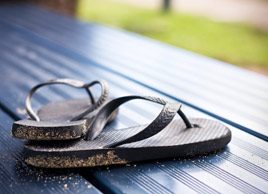Are flip-flops ruining your feet?
Get the lowdown on the hidden hazards of flip-flops and find out how to choose summery shoes that won’t wreck your feet

Source: Web exclusive, June 2009
When the temperature rises, our first instinct is to peel off the layers, pull out the tank tops and shorts and kick back in some breezy flip-flops. And for many of us, multicoloured rubber thongs have become our summer footwear of choice. But while they may help you stay comfortable and cool off, those inexpensive sandals are anything but kind to your feet.
What flip-flops can do to your feet
While there’s no doubt they’re comfy and go with just about any outfit, rubber flip-flops aren’t really meant to be worn beyond the pool. The problem, say podiatrists, who see a spike in visits to their offices in the summer months, is that we’ll walk in flip-flops everywhere from the park to the beach and back to the office without regard to the damage we’re doing to our feet. ‘Inadequate support in the foot over prolonged periods leads to a strain in the arch ligaments,’ says Toronto-based podiatrist Andrew S. Klayman. ‘This causes severe pain in the heel and arch region of the foot known as plantar fasciitis.’ And plantar fasciitis, says Klayman, often requires treatment by a podiatrist.
Flip-flops’ lack of support also causes your feet and legs to overcompensate. ‘[Wearing flip-flops] causes toes to contract, making the muscles in the front of the leg work when they should be at rest,’ says Vancouver-based podiatrist Roy Mathews. The result? The formation of hammertoes, a foot deformity where the second, third or fourth toe is bent at the joint, resembling a hammer. Definitely not worthy of foot-baring season. Ankle sprains are another common condition associated with wearing flip-flops, says Klayman. ‘The lack of counter-support in a shoe causes your foot and ankle to roll over on its side, potentially tearing your ankle ligaments,’ he says.
But it doesn’t stop there: Klayman adds that these sandals can also wreak havoc on your knees, hips and back. ‘The structure of the flip-flop has no support in the arch or heel, leading to an unstable gait,” he says’and this can cause bad alignment, leading to strains in your knees and lower back. And for those who overpronate, says Klayman, ‘flip-flops should be avoided at all cost due to no arch support or foot control.’
How to choose sandals that are good for your feet
You don’t necessarily need to sacrifice style in the quest for smarter footwear this summer. Save the basic flip-flops for the beach and backyard, and invest in something cute and supportive for when you’re walking around. Here are some tips for what to look for:
‘ Choose a sandal with a supportive yet lightweight outer sole that provides shock absorption, and stay away from the ‘floppy brands,’ says Klayman.
‘ Look for a cradle around the heel, to reduce your chances of ankle sprains, says Klayman.
‘ Cork soles are better than most rubber soles, says Mathews, who adds that ‘a slight wedge can be better for some with higher arches.’
‘ Orthotic sandals, such as those by Naot, Birkenstock, Bite and Wolky, can be a better option, says Klayman.
‘ Go for solid straps, such as Velcro strapping or a pulley-lock fit system in technical support sandals, which can help hold your foot in place.
Get inspired with our slideshow of cute’and foot-friendly’summer sandals.
Don’t miss out! Sign up for our free weekly newsletters and get nutritious recipes, healthy weight-loss tips, easy ways to stay in shape and all the health news you need, delivered straight to your inbox.




